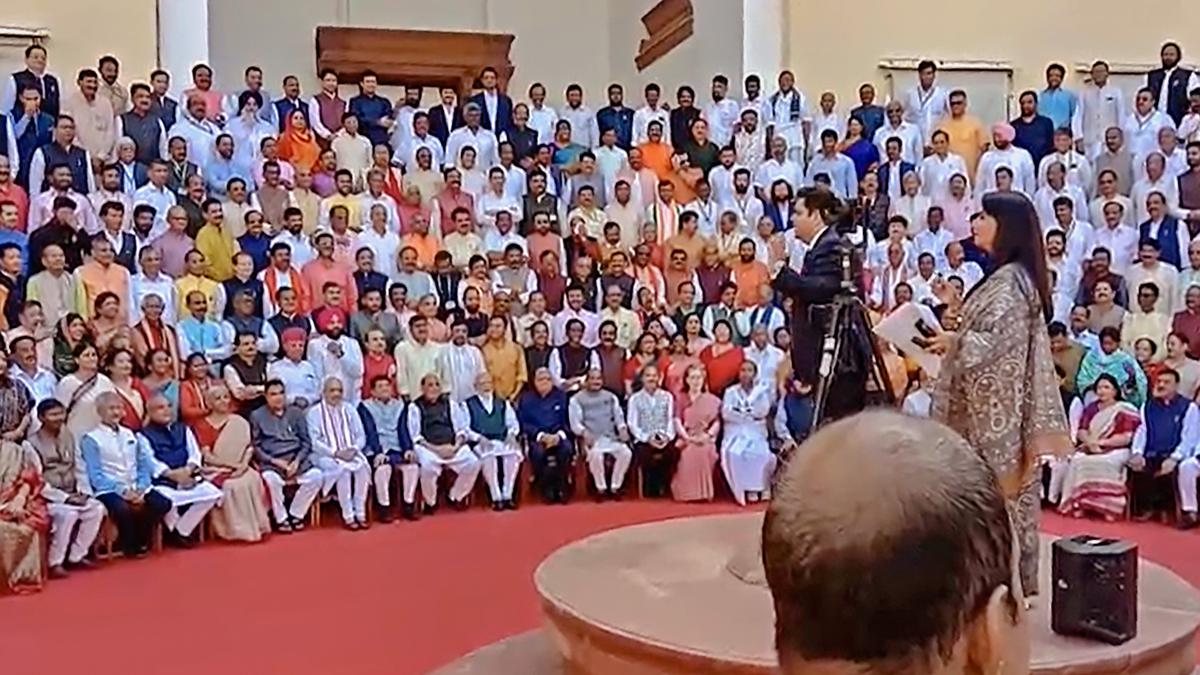
MPs turn up in myriad colours for farewell pic at old Parliament building
The Hindu
Women members turned up in colourful sarees, while most of their male counterparts preferred white kurta-pyjamas with vibrant waist-coats for the photo-session.
Dressed in colourful attire, members of the Lok Sabha and the Rajya Sabha on September 19 got their group photograph clicked in the old Parliament building, hours before legislative proceedings shift to the new Parliament House.
Vice President and Rajya Sabha Chairman Jagdeep Dhankhar, flanked by Prime Minister Narendra Modi and Lok Sabha Speaker Om Birla on either side, was seated on the inner courtyard of the old Parliament building.
Also read | Parliament special session live updates
Union Home Minister Amit Shah, Defence Minister Rajnath Singh, Leader of the Opposition in the Rajya Sabha Mallikarjun Kharge, Congress leader in Lok Sabha Adhir Ranjan Chowdhury, former Congress president Sonia Gandhi, Samajwadi Party Lok Sabha member 93-year-old Shafiq-ur-Rahman Barq, veteran leaders Sharad Pawar (NCP) and Farooq Abdullah (NC) and BJP president J.P. Nadda were among those seated in the first row.
Women members turned up in colourful sarees, while most of their male counterparts preferred white kurta-pyjamas with vibrant waist-coats for the photo-session.
The early morning session had some anxious moments as BJP Rajya Sabha member Narhari Amin fainted. Mr. Shah, Commerce Minister Piyush Goyal and some leaders rushed to his rescue. Officials were seen offering water to the 68-year-old Amin, who soon joined the group photo.
Congress leader Rahul Gandhi was seen standing in the second last row with Manish Tewari for company. Some members were seen squatting on the floor as members of the Rajya Sabha and the Lok Sabha got their photographs clicked.

“Writing, in general, is a very solitary process,” says Yauvanika Chopra, Associate Director at The New India Foundation (NIF), which, earlier this year, announced the 12th edition of its NIF Book Fellowships for research and scholarship about Indian history after Independence. While authors, in general, are built for it, it can still get very lonely, says Chopra, pointing out that the fellowship’s community support is as valuable as the monetary benefits it offers. “There is a solid community of NIF fellows, trustees, language experts, jury members, all of whom are incredibly competent,” she says. “They really help make authors feel supported from manuscript to publication, so you never feel like you’re struggling through isolation.”

Several principals of government and private schools in Delhi on Tuesday said the Directorate of Education (DoE) circular from a day earlier, directing schools to conduct classes in ‘hybrid’ mode, had caused confusion regarding day-to-day operations as they did not know how many students would return to school from Wednesday and how would teachers instruct in two modes — online and in person — at once. The DoE circular on Monday had also stated that the option to “exercise online mode of education, wherever available, shall vest with the students and their guardians”. Several schoolteachers also expressed confusion regarding the DoE order. A government schoolteacher said he was unsure of how to cope with the resumption of physical classes, given that the order directing government offices to ensure that 50% of the employees work from home is still in place. On Monday, the Commission for Air Quality Management in the National Capital Region and Adjoining Areas (CAQM) had, on the orders of the Supreme Court, directed schools in Delhi-NCR to shift classes to the hybrid mode, following which the DoE had issued the circular. The court had urged the Centre’s pollution watchdog to consider restarting physical classes due to many students missing out on the mid-day meals and lacking the necessary means to attend classes online. The CAQM had, on November 20, asked schools in Delhi-NCR to shift to the online mode of teaching.









